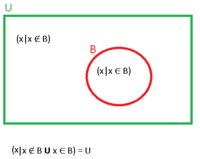Leandrowski
New member
- Joined
- Jan 12, 2020
- Messages
- 5
Sort on true or false this sentence:
(A-B)∪(A∩B) = A
Ok, we know that: (A-B) = (x|x ∈ A ∧ x ∉ B)
we also know that: (A∩B) = (x|x ∈ A ∧ x ∈ B)
resulting in the sentence = (x|x ∈ A ∧ x ∉ B) ∪ (x|x ∈ A ∧ x ∈ B)
True or false? why? i need help.
OBS: i'm brazillian, sorry my english.
(A-B)∪(A∩B) = A
Ok, we know that: (A-B) = (x|x ∈ A ∧ x ∉ B)
we also know that: (A∩B) = (x|x ∈ A ∧ x ∈ B)
resulting in the sentence = (x|x ∈ A ∧ x ∉ B) ∪ (x|x ∈ A ∧ x ∈ B)
True or false? why? i need help.
OBS: i'm brazillian, sorry my english.


